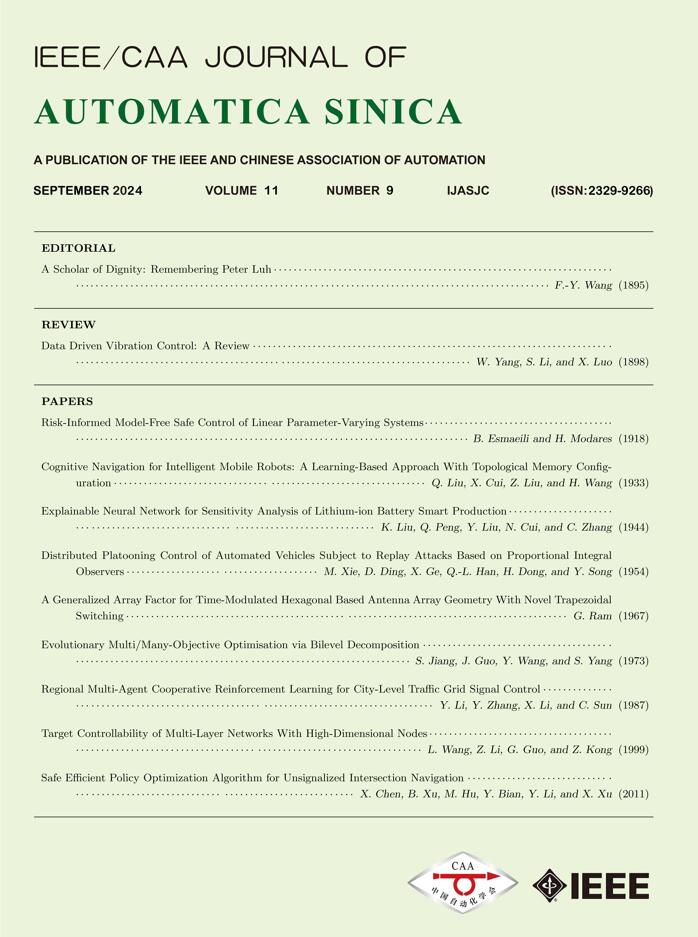 Volume 11
Issue 9
Volume 11
Issue 9
IEEE/CAA Journal of Automatica Sinica
| Citation: | K. Shao, K. Huang, S. Zhen, H. Sun, and R. Yu, “A novel approach for trajectory tracking control of an under-actuated quad-rotor UAV,” IEEE/CAA J. Autom. Sinica, vol. 11, no. 9, pp. 2030–2032, Sept. 2024. doi: 10.1109/JAS.2016.7510238 |

| [1] |
B. J. Emran and H. Najjaran, “A review of quadrotor: An underactuated mechanical system,” Annu. Rev. Control, vol. 46, pp. 165–180, 2018. doi: 10.1016/j.arcontrol.2018.10.009
|
| [2] |
J. Moreno-Valenzuela, R. Pérez-Alcocer, M. Guerrero-Medina, and A. Dzul, “Nonlinear PID-type controller for quadrotor trajectory tracking,” IEEE Trans. Mechatronics, vol. 23, no. 5, pp. 2436–2447, 2018. doi: 10.1109/TMECH.2018.2855161
|
| [3] |
C. Trapiello, V. Puig, and B. Morcego, “Position-heading quadrotor control using LPV techniques,” IEEE Contr. Syst. Lett., vol. 13, no. 6, pp. 783–794, 2019.
|
| [4] |
H. E. Glida, L. Abdou, A. Chelihi, C. Sentouh, and S.-E.-I. Hasseni, “Optimal model-free backstepping control for a quadrotor helicopter,” Nonlinear Dyn., vol. 100, no. 4, pp. 3449–3468, 2020. doi: 10.1007/s11071-020-05671-x
|
| [5] |
S. Lian, W. Meng, K. Shao, J. Zheng, S. Zhu, and H. Li, “Full attitude control of a quadrotor using fast nonsingular terminal sliding mode with angular velocity planning,” IEEE Trans. Ind. Electron., vol. 70, no. 4, pp. 3975–3984, 2023. doi: 10.1109/TIE.2022.3176314
|
| [6] |
H. A. Foudeh, P. Luk, and J. Whidborne, “Application of norm optimal iterative learning control to quadrotor unmanned aerial vehicle for monitoring overhead power system,” Energies, vol. 13, no. 12, pp. 3223–3236, 2020. doi: 10.3390/en13123223
|
| [7] |
F. E. Udwadia and R. E. Kalaba, “Analytical dynamics: A new approach”, Cambridge, UK: Cambridge University Press, 1996.
|
| [8] |
Y.-H. Chen, “Mechanical systems under servo constraints: The Lagrange’s approach,” Mechatronics, vol. 15, no. 3, pp. 317–337, 2005. doi: 10.1016/j.mechatronics.2004.09.003
|
| [9] |
Y.-H. Chen, “Equations of motion of mechanical systems under servo constraints: The Maggi approach,” Mechatronics, vol. 18, no. 4, pp. 208–217, 2008. doi: 10.1016/j.mechatronics.2007.12.004
|
| [10] |
A. H. Bajodah, D. H. Hodges, and Y.-H. Chen, “Inverse dynamics of servo-constraints based on the generalized inverse,” Nonlinear Dyn., vol. 39, pp. 179–196, 2005. doi: 10.1007/s11071-005-1925-x
|
| [11] |
Y.-H. Chen, “Constraint-following servo control design for mechanical systems,” J. Vib. Control, vol. 15, no. 3, pp. 369–389, 2009. doi: 10.1177/1077546307086895
|
| [12] |
A. D. Schutte, “Permissible control of general constrained mechanical systems,” J. Franklin Inst., vol. 347, no. 1, pp. 208–227, 2010. doi: 10.1016/j.jfranklin.2009.10.002
|
| [13] |
F. E. Udwadia, “A new perspective on the tracking control of nonlinear structural and mechanical systems,” Proc. R. Soc. Lond., vol. 459, pp. 1783–1800, 2003. doi: 10.1098/rspa.2002.1062
|
| [14] |
P. B. Koganti and F. E. Udwadia, “Unified approach to modeling and control of rigid multibody systems,” J. Guid. Control Dyn., vol. 39, no. 12, pp. 1–16, 2016.
|
| [15] |
R. Yu, Y.-H. Chen, H. Zhao, and H. Sun, “Uniform ultimate boundedness for underactuated mechanical systems as mismatched uncertainty disappeared,” Nonlinear Dyn, vol. 95, pp. 2765–2782, 2019. doi: 10.1007/s11071-018-4721-0
|